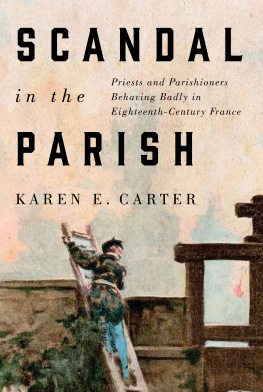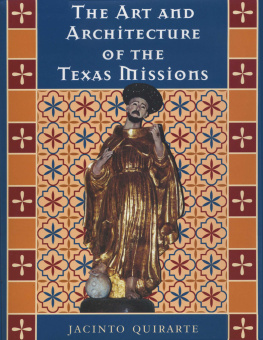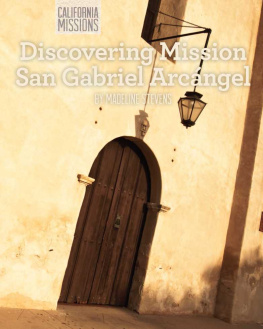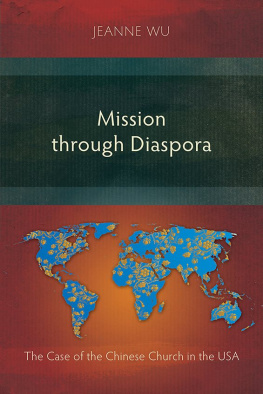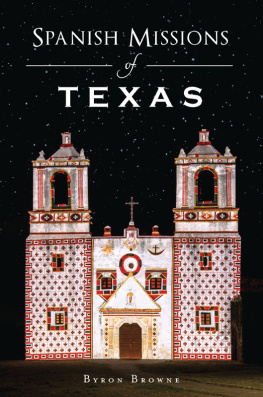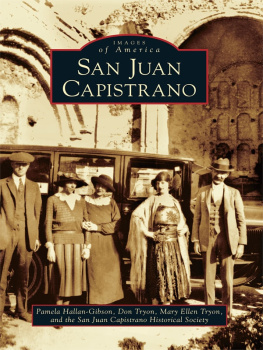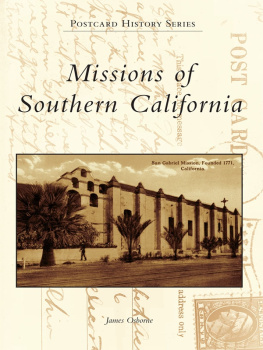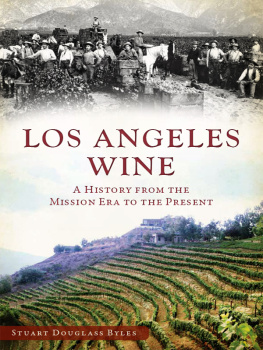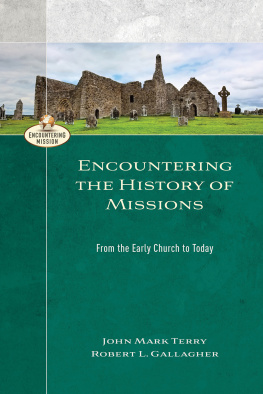Catholic Church - Missions of Los Angeles
Here you can read online Catholic Church - Missions of Los Angeles full text of the book (entire story) in english for free. Download pdf and epub, get meaning, cover and reviews about this ebook. City: El Camino Real (Calif.);Los Angeles (Calif.);Los Angeles Plaza (Los Angeles;Calif.);California;Los A, year: 2013;2014, publisher: Arcadia Publishing, genre: Religion. Description of the work, (preface) as well as reviews are available. Best literature library LitArk.com created for fans of good reading and offers a wide selection of genres:
Romance novel
Science fiction
Adventure
Detective
Science
History
Home and family
Prose
Art
Politics
Computer
Non-fiction
Religion
Business
Children
Humor
Choose a favorite category and find really read worthwhile books. Enjoy immersion in the world of imagination, feel the emotions of the characters or learn something new for yourself, make an fascinating discovery.

- Book:Missions of Los Angeles
- Author:
- Publisher:Arcadia Publishing
- Genre:
- Year:2013;2014
- City:El Camino Real (Calif.);Los Angeles (Calif.);Los Angeles Plaza (Los Angeles;Calif.);California;Los A
- Rating:5 / 5
- Favourites:Add to favourites
- Your mark:
- 100
- 1
- 2
- 3
- 4
- 5
Missions of Los Angeles: summary, description and annotation
We offer to read an annotation, description, summary or preface (depends on what the author of the book "Missions of Los Angeles" wrote himself). If you haven't found the necessary information about the book — write in the comments, we will try to find it.
Missions of Los Angeles — read online for free the complete book (whole text) full work
Below is the text of the book, divided by pages. System saving the place of the last page read, allows you to conveniently read the book "Missions of Los Angeles" online for free, without having to search again every time where you left off. Put a bookmark, and you can go to the page where you finished reading at any time.
Font size:
Interval:
Bookmark:
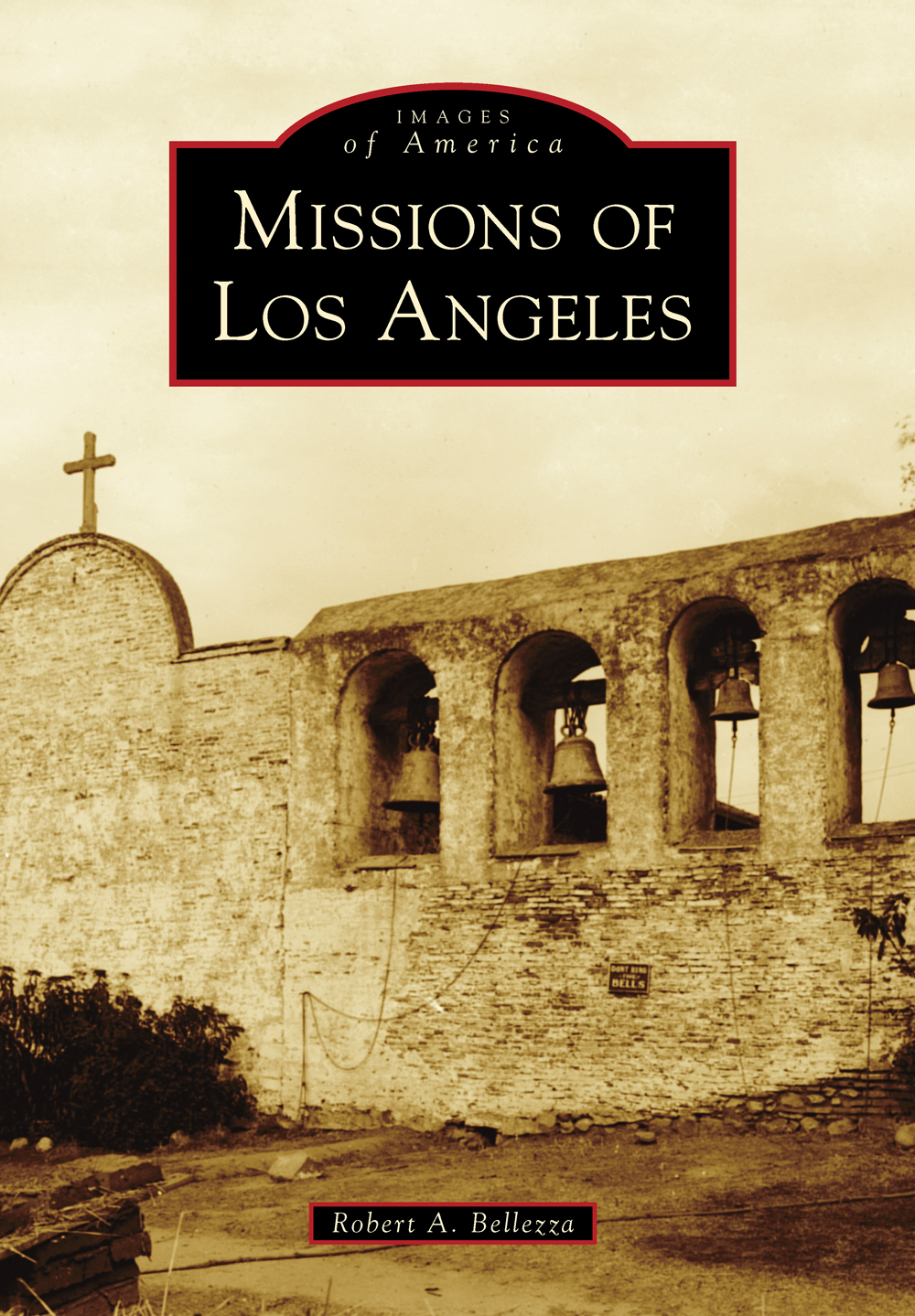
IMAGES
of America
MISSIONS OF
LOS ANGELES

A reminder of romantic mission days, the Old Mission San Fernando de Espaa landscape is portrayed by century-old twin palms symbolic of the southern scenery of Alta California traveled by its founder, mission president Fr. Junpero Serra. (Authors collection.)
ON THE COVER: The Jewel of the Missions, Mission San Juan Capistrano, and the bell wall, are a remarkable part of mission history. This glass plate photograph taken in 1928 depicts Californias seventh Spanish missions stone walls and tower bells after they toppled to the ground during the violent 1812 earthquake. The original bells were recovered from the Great Stone Church, completed in 1806. Its destruction, a tragic catastrophe, left 40 mission Indians dead among its ruins. The bells fell with the collapse of the 120-foot tall tower and the churchs domed roof. (Authors collection.)
IMAGES
of America
MISSIONS OF
LOS ANGELES
Robert A. Bellezza

Copyright 2013 by Robert A. Bellezza
ISBN 978-0-7385-9681-5
Ebook ISBN 9781439644324
Published by Arcadia Publishing
Charleston, South Carolina
Library of Congress Control Number: 2013938536
For all general information, please contact Arcadia Publishing:
Telephone 843-853-2070
Fax 843-853-0044
E-mail
For customer service and orders:
Toll-Free 1-888-313-2665
Visit us on the Internet at www.arcadiapublishing.com
To my son, Tony Bellezza, and his wife, Christina, proud parents of my two talented granddaughters.
CONTENTS
ACKNOWLEDGMENTS
The Library of Congress Prints & Photographs Online Collection has supplied the majority of images within this volume and makes possible a review of Californias founding architectural landmarks practically lost through centuries of age, deterioration, and neglect. Californias mission buildings were rescued only after the majority had suffered the effects of earthquakes, irreversible weathering, and ruin to the adobe walls. The work employing the Civilian Conservation Corps and photographers from the 1933 New Deal documented the progress or decay of the many iconic structures through the Historic American Buildings Survey. Unless otherwise indicated, all images are courtesy of the Library of Congress, Historic American Buildings Survey/Historic American Engineering Record/Historic American Landscapes Survey.
By the beginning of the 20th century, there had been efforts made to preserve the earliest missions, often built and decorated entirely by California natives. My gratitude to both Jim Beardsley and Chuck Lyons, from Mission San Fernando Rey de Espaa and Mission San Gabriel, respectively, who opened the doors to my research at the original mission sites. Several photographs within this volume are released for the first time from my collection and from the Anderson familys collection of vintage glass plates. Many up-to-date mission photographs featured in are from my visits to each area.
We are truly pleased our books release coincides with the 300th anniversary of Fr. Junpero Serras birth. Miguel Josep Serra (Junpero was his chosen religious name) was born on November 24, 1713, in Petra, Majorca, one of the Balearic Islands, located some 150 miles off the coast of the Spanish mainland.
INTRODUCTION
SPANISH COLONIZATION IN ALTA CALIFORNIA
The dawn of conquest by foreign land and sea expeditions into Alta California brought far-seeing Franciscan padres with Spanish explorers insight to colonize the newly discovered land in 1769. The task of reaching natives of the north and building new mission settlements replicated previous Franciscan missionaries practices in Baja California overseen by the mission president, Fr. Junpero Serra. The first friars founded 21 Alta California mission colonies under alliance to the Spanish crown. The first settlement and military presidio established at Mission San Diego de Alcal spawned a system over the next 54 years of huge tracts of land with many small chapels, or mission asistencias, connecting the neighboring ranchos. The San Diego port delivered steady loads of settlers, supplies, skilled craftsmen, carpenters, masons, farmers, livestock, and pack mules from San Blas, Mexico. The first friars relentless devotion to their faith captured the imagination of fellow countrymen, and their exuberant expectations gained the loyalty of neophyte mission Indians inducted into the settlements as a steady labor force. Mission Indians gathered within the sanctity of the mission grounds over generations, accepted baptisms, and lived with their families under the constant guard of soldiers. A neophyte mission Indian was subjected to the ceremonies of the culture and strict daily practices while also being influenced by outlying tribal elders resisting the invaders. Among their far-reaching goals, the Spanish friars ultimately planned to entrust the developed lands at the missions to neophyte devotees in accordance with a new and more perfected way of life. In 1821, the system of 21 mission colonies suffered under the new Mexican secularization laws, and properties were divided into private ownership and used to pay off debts and extend favors. The majority of the early adobe dwellings at the missions and neighboring ranchos have long ago disappeared into the soil.
MOUNTING FORCES OPPOSING SPAIN
Although mission Indians were aligned with the industrious friars, living in close quarters near undisciplined Spanish soldiers often forced conflicts upon the neophyte families. The soldiers often destroyed relationships built by the friars in their attempts to establish an early rapport with natives. A rebellion within Mexico against its mother county that began in 1810 brought changes of governance within Alta California by 1822. The absence of Spanish ministers residing in Alta California, along with internal revolution inside Mexico City, led to a new Republic of Mexico ready to dismantle the clergys administration of the Alta California colonies. Mexico City rescinded its solemn bond with the Franciscan friars, ending supplies from San Blas and leaving settlers dependent on support from the mission colonies. The mission Indians, who were reliant on agricultural resources and industries, witnessed the disbanding and sale of properties and ranchos. Changes under new laws within California helped foster a lawless period of politicians eager to divide or sell the mission lands, favoring Mexican vaqueros control of the expansive grazing ranges. At a period of peak prosperity in 1832, many settlements had become self-sufficient but were subjected to increasing taxes and property loss. Groups of revered Franciscan friars sent to join the Alta California mission communities from Mexico Citys San Fernando College were replaced by Mexican friars and secular priests. Political power diminished the padres abilities to manage mission properties, encouraging many to flee to their homelands. The short-lived 25-year period would conclude in 1848 with the Treaty of Guadalupe Hidalgo. During the period of disarray at the settlements, Mission San Gabriel, Arcngel, was sold to private landholders, one of the last mission properties sold by Mexicos last governor, Pio Pico.
EMERGING TOWNS
On the banks of Rio de los Tremblores, todays Santa Ana River and first site of Mission San Gabriel, Arcngel, Father Serra performed the first California wedding in 1774. Fourth in the Alta California chain, the mission was moved five miles to its present location, and the existing Moorish-influenced edifice was dedicated in 1796. Nine miles from Mission San Gabriel, Arcngel, the rising population of new settlers at El Pueblo de Los Angeles dedicated an asistencia, the original church of 1818, founded by mission friars. The explorer, Gaspar de Portol, gave the Los Angeles River its name during his first expedition of 1769 after a Franciscan chapel in Porcincula, Italy. The name honored Mary, and its namesake, the Church of Our Lady the Queen of the Angels, was established. La Iglesia de Nuestra Seora la Reina de los Angeles, commonly named La Placita, is called the Plaza Church. Master mason Jos Antonio Ramirez, who was among the builders at Mission San Carlos Borromeo in Monterey, became the builder of the Los Angeles asistencia during his stay at San Gabriel. Nearby, in Orange County, Mission San Juan Capistrano had been founded by Fr. Junpero Serra in 1776 as the seventh mission, further closing the gap between missions to the north. Mission San Fernando Rey de Espaa, founded by Fr. Fermn Francisco de Lasun in 1797, served friendly aboriginal Tataviam tribes in neighboring regions. The mission created thriving industries producing hides, tallow, soap, and cloth in large quantities, which were then sold to other missions or ranchos. On the well-worn paths traveled by increasing numbers coming to Los Angeles, one stopover, named Camulos Rancho, was a well-known
Font size:
Interval:
Bookmark:
Similar books «Missions of Los Angeles»
Look at similar books to Missions of Los Angeles. We have selected literature similar in name and meaning in the hope of providing readers with more options to find new, interesting, not yet read works.
Discussion, reviews of the book Missions of Los Angeles and just readers' own opinions. Leave your comments, write what you think about the work, its meaning or the main characters. Specify what exactly you liked and what you didn't like, and why you think so.





